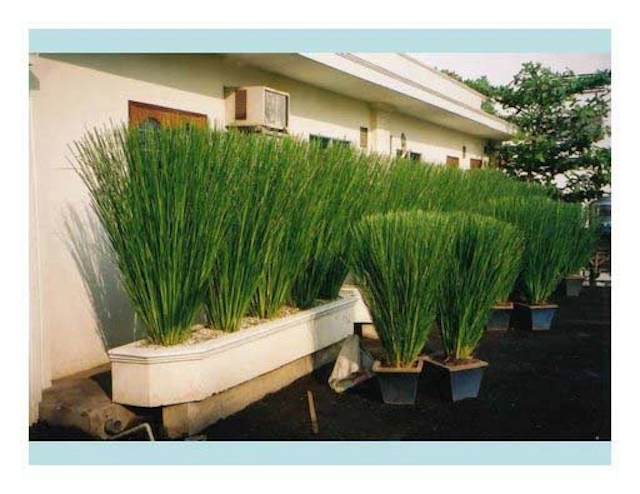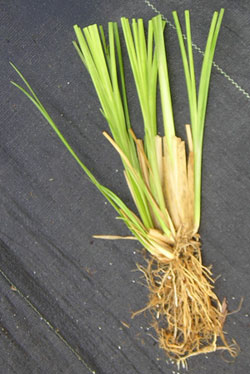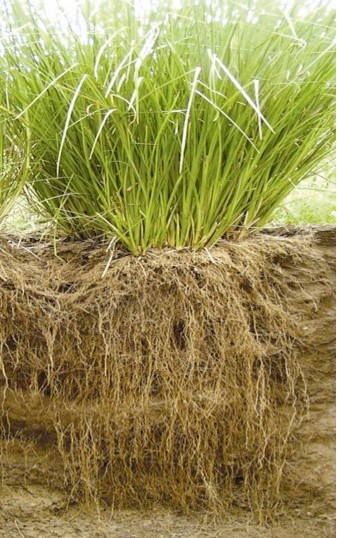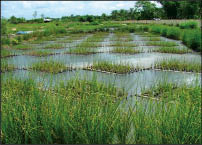
SPRING 2025 VETIVER GRASS SALES ARE OPEN
If you have questions about Vetiver please contact me. cindy@theherbcottage.com or 361-258-1192
There is LOTS of information about Vetiver Grass here. Please read and inform yourself.

This is ONE vetiver slip, trimmed and ready to be packed up and mailed to you. Height is 10″ – 12″ including the root ball.
I accept orders until about 3 days before harvest. Harvest will start May 10. Placing your order now assures your place in the queue. Your order is then added to the number of slips we process during harvest.
I will start shipping on May 12.
I fill orders in the order I receive them.
PLEASE READ
As soon as I see your order, which may be a day or even two after you place the order, I will email you and let you know I’ve received the order AND give you an approximate date of shipping. PLEASE CHECK YOUR EMAIL WITHIN A DAY OR 2 OF PLACING YOUR ORDER FOR AN EMAIL FROM THE HERB COTTAGE. If you requested a text notice, I will text you that I have received your order and give you an approximate date for shipping.
Shipping and Tracking
I will make sure you get shipping and tracking information. So, check your EMAIL around the approximate date for shipping that I originally gave you so you know when the package is supposed to arrive. If I can, I will also TEXT you.
Damage and Return Policy
Late Delivery
I use USPS Priority Mail or UPS to ship my packages, whichever is the most economical for fastest shipping. Over the last few years Priority Mail has had its problems. I ship many packages of Vetiver Grass and occasionally a shipment arrives very late- rarely not at all. All packages are insured so I can recover my cost and replace the order for you or reimburse you for the order.
Damage
Vetiver Grass is very forgiving and tenacious. Even if your Vetiver Grass has been in the mail a week, unless it was left in the blazing sun somewhere along the way, it should recover with some TLC from you. Follow the instructions included with your order. Contact me for help. I want your Vetiver Grass to survive and thrive. Please take pictures of the shipment in case it does not recover. I will reimburse you or replace your order. But, I need pictures to file a claim, so I can recover my cost.
Grass is DOA
IF your Vetiver Grass is totally DOA (dead on arrival), please, please let me know immediately. And, take pictures. I will reimburse you or replace your order, whichever you choose. But, I need pictures to file a claim, so I can recover my cost.
You must notify me within 3 days of receiving your shipment if there is a problem. If you wait longer than that, I cannot help you. If your shipment is late and still looks OK and you follow the instructions and the grass doesn’t thrive, I still need pictures of the grass when it arrived. Please contact me within the 3 day window so I know you’re waiting to see if the grass recovers or not.
Often your slips will have many dried leaves around green center leaves. This is normal. Plant as instructed and keep slightly moist. This can be done either in pots or in the ground. If there is green in the clump of grass showing, your slip will put out new roots and eventually new green growth.
As always, please contact me for help.
Text: 361-258-1192
email: cindy@theherbcottage.com
Returns
I DO NOT take returns. If the grass is dead, compost it. Notify me within the 3 day window and send me pictures. I will either reimburse you or replace it for you, your choice. BUT, I can do nothing without pictures.
I hope you understand my policy. It is not meant to be harsh, but I have no control over the shipment once it leaves my hands. And, I realize you also have no control over the order when it’s in transit. So, let’s work together to make sure your experience with Vetiver Grass and The Herb Cottage is a positive one and than we are both happy with your purchase and subsequent growth of the Vetiver Grass.
SHOP NOW
You can order in multiples of any set amount of slips. If you want 6 slips, order 2 sets of 3 slips. If you want 50 slips, order 2 sets of 25 slips, etc.
For orders of more than 500 slips, please contact me. Thank you. cindy@theherbcottage.com or 361-258-1192
Shipping Rates are based on total order cost
- $0 – $40 = $7.00
- $41 – $99 = $15.00
- $100 – $300 = $25.00
- $400 – $500 = $50.00
Thank you so much for your interest in Vetiver Grass from The Herb Cottage.
VETIVER GRASS PLANT SALES ONLY FOR SHIPMENT TO THE UNITED STATES AND U.S. TERRITORIES.
If you have questions about Vetiver Grass, there is lots of information in the sections below.
If you still have questions, I will happily respond to emails, phone calls and texts regarding growing, planting and other concerns regarding Vetiver.
Vetiver Grass is an ancient plant that has grown around the world to great benefit for centuries. It has myriad uses: erosion control, livestock forage, bioremediation. The aromatic roots are steam distilled for essential oil and hydrosols. The “leaves” are used to thatch buildings and create a vast array of footwear, hats, mats and decorative items. There is no part of the plant that goes unused.
Vetiver Grass is propagated by division, as seen in the slip, below. This was taken off a larger plant that was dug and divided. There are NO SEEDS for the non-invasive, hybrid variety called Sunshine, that I sell. If you buy Vetiver Grass seed somewhere on-line, know it will be invasive. It is NOT what I sell.
The Sunshine variety of Vetiver does not run, nor does it produce viable seed. It may flower in a long warm season, but no seeds will be produced. The clump of Vetiver Grass grows larger as time goes on, but the clump stays where you planted it. No runners, like you get with Running Bamboo.

VETIVER GRASS PLANT SALES ONLY FOR SHIPMENT TO THE UNITED STATES AND U.S. TERRITORIES.
About Vetiver Grass
 The name comes from “vetiver,” a Tamil word meaning “root that is dug up.” The zizanioides was given by Linnaeus in 1771 and means “by the riverside.” As you would guess, the native habitat of this grass is in low, damp sites such as swamps and bogs. In spite of that, the grass is now being used on dry hillsides to control erosion.
The name comes from “vetiver,” a Tamil word meaning “root that is dug up.” The zizanioides was given by Linnaeus in 1771 and means “by the riverside.” As you would guess, the native habitat of this grass is in low, damp sites such as swamps and bogs. In spite of that, the grass is now being used on dry hillsides to control erosion.
Vetiver, Cymbopogon zizanioides ,
is a member of the same grass family as maize, sorghum, sugar cane and lemongrass.
Vetiver is a clumping type grass, non-invasive. The variety I sell is called Sunshine.
The roots are very deep, so it’s best to decide carefully where to plant it because it is very hard to dig up. It can be grown in a container as well, for a lovely effect.
The above-ground plant looks much like pampas grass or lemon grass.
Vetiver is a tropical plant and will not survive prolonged cold winters where the ground freezes.
Hardiness
Its northern limit is probably Zone 7, although given protection, mild winters and heavy mulching it will grow farther north. The other condition it will not tolerate is full shade. Dappled light is OK, as is half day sun, half day shade.
If you’re looking for a screen plant, a grass to grow in a low, boggy area, a plant for erosion control or an attractive container grass, try Vetiver. Join a world wide group of people who have discovered Vetiver and its very positive impact on horticulture, ecology and more.
Massive Root System
It is a big, coarse clumping grass that can grow to be very tall. It provides a considerable amount of biomass that can be used for mulching or composting. In many areas of the world, the grass is used for thatching roofs.
It is the root of the plant that makes it valuable – whether for perfume or erosion control.
Vetiver produces a massive root system that grows straight down rather than out from the plant. It creates a sort of curtain beneath the soil, trapping sediment and slowing down the movement of water.
Non-invasive
Because the grass grows down instead of outward, it does not become invasive. The plants never form seeds, in fact they rarely flower, and if they do, the seed is sterile, another advantage in keeping it under control.

Erosion Control… and more
In 1989 Fort Polk in Louisiana was having a problem with erosion.
Three scenic streams came together on the base, but tanks and other military equipment was ripping up the land and causing soil and silt to fill up the natural waterways. Mike Materne, the local U.S. Soil Conservation Service agent, brought in some vetiver plants and planted them in the bare slopes above the dams that held runoff water.
In spite of the very acidic, rocky soil that contained virtually no fertility, the slips of grass began to grow. In eight weeks, some were almost 2 meters tall and in 10 weeks they had grown together into hedges. Sediment began to build up behind the hedges and the water that went down the streams into the catch ponds became clear.
It soon became clear that vetiver was acting as much more than an erosion trap: it was a “nurse plant” that was protecting other species and thereby giving these devastated watersheds a chance to heal themselves. Native grasses, wildflowers, shrubs, trees and vines came crowding in behind the hedges and grew to re-vegetate the site.
Adaptable
The crown of the plant is adaptable to rising soil levels.
As the sediment builds up around the plant, the crown grows upward and is not damaged by soil being piled around it.
Although vetiver goes dormant in the winter or very dry seasons, its stems and leaves stay stiff and firmly attached to the crown. This means that the plant continues to stop soil movement even though it is not actively growing.
Vetiver grass will tolerate high levels of nitrates, phosphates, heavy metals, and agricultural chemicals.
It can be used for treating wastewater, rehabilitating mine tailings, stabilizing landfills and general rubbish dumps. The grass takes up the toxic materials and confines the contaminates to the effected area.

Vetiver pontoon in pig farm ponds in Bien Hoa, Viet Nam
Plantings like this clean wastewater from pig farms, mines and even mills.
Aromatic
Leaves of the plant are odorless, however the roots have an exquisite and long lasting scent, similar to the aroma of sandalwood. An open bowl of dried vetiver root can give off a most pleasing aroma for a very long time.The roots of the plant have been used for centuries as a source of essential oil that makes a wonderful perfume. It is also used for scenting soaps, and it is used in some countries as a flavoring in canned asparagus and sherbets.
